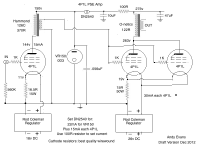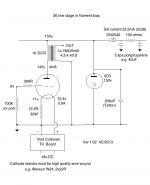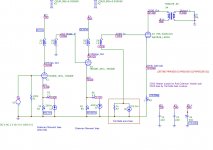Peter - I am sure you are thinking that a 300b output stage will be the best. Everyone does. But this would be wrong. I built several 300b SETs and I can tell you that you will get better sound out of a PSE 4P1L output stage in filament bias. I'm re-posting my amp and preamp schematics. If you build these pretty much exactly as shown you will be very surprised at what you hear. The filament bias - no cathode bypass caps, small resistor - is what makes the sound ultra transparent. And this in itself is enough to make it a better choice than a 300b with large resistor and cathode bypass. Add to that the 4P1L is a very fine sounding tube in its own right, and you will see what I mean. I'm converting all my 300b SETs to PSE 4P1L. It's fairly easy to do this - two 4P1L in parallel have 1.3A current and are biased at 2x35mA = 70mA. You do need 28vDC for the filament supply to Rod's regulators, one for each pair of 4P1L, but that's not difficult.
Attachments
Last edited:
Hi Andy,
Thanks, nice to have your current schematic.
You are probably right about a PSE 4P1L being better for me than a 300B it's just that I have a lot of iron for the PS and OPT which is not suitable for a 4P1L PSE.
PS output is 500VDC so I am kind of stuck with a 300B-XLS and want to finish this before trying anything else.
Have a look at http://www.diyaudio.com/forums/tubes-valves/238060-driver-options-300b-xls-4p1l-4p1l.html .
The 300B has fixed bias so at least there is no resistor and cathode bypass cap.
Regards,
Peter
Thanks, nice to have your current schematic.
You are probably right about a PSE 4P1L being better for me than a 300B it's just that I have a lot of iron for the PS and OPT which is not suitable for a 4P1L PSE.
PS output is 500VDC so I am kind of stuck with a 300B-XLS and want to finish this before trying anything else.
Have a look at http://www.diyaudio.com/forums/tubes-valves/238060-driver-options-300b-xls-4p1l-4p1l.html .
The 300B has fixed bias so at least there is no resistor and cathode bypass cap.
Regards,
Peter
Peter - I am sure you are thinking that a 300b output stage will be the best. Everyone does. But this would be wrong. I built several 300b SETs and I can tell you that you will get better sound out of a PSE 4P1L output stage in filament bias. I'm re-posting my amp and preamp schematics. If you build these pretty much exactly as shown you will be very surprised at what you hear. The filament bias - no cathode bypass caps, small resistor - is what makes the sound ultra transparent. And this in itself is enough to make it a better choice than a 300b with large resistor and cathode bypass. Add to that the 4P1L is a very fine sounding tube in its own right, and you will see what I mean. I'm converting all my 300b SETs to PSE 4P1L. It's fairly easy to do this - two 4P1L in parallel have 1.3A current and are biased at 2x35mA = 70mA. You do need 28vDC for the filament supply to Rod's regulators, one for each pair of 4P1L, but that's not difficult.
I only use DHTs so that's all I'd recommend - 26 into 4P1L, both in filament bias. Same transformers as in my schematics, but you would need to run the driver stage with more volts on the plate and probably more like 20-30mA through it. You could use the Hammond 126B. Haven't tried that - just the 126C. So in filament bias you'd be looking at more like a 24vDC supply to Rod's regs. Say 25mA, -15v, 200v p-k. You could use a couple of 105v glow tubes.
I also want to go for all DHT, I like how 2x 4P1L simulates and a quick test with 6J5-4P1L-300B sounded promising.
With the 4P1L-IS-4P1L-IS 18W would require 3.85Vpp at the input, driver clipping starts at 5.6Vpp (1.98Vrms)
Interstages will be custom made by Tribute so I can choose any anode current I like.
Why did you suggest the 26 iso 4P1L as first tube?
With the 4P1L-IS-4P1L-IS 18W would require 3.85Vpp at the input, driver clipping starts at 5.6Vpp (1.98Vrms)
Interstages will be custom made by Tribute so I can choose any anode current I like.
Why did you suggest the 26 iso 4P1L as first tube?
Attachments
Last edited:
26 is much better sounding than 6J5, especially in filament bias. 4P1L is microphonic for an input tube.
4P1L as input tube seems doable since you are using the 4P1L as input tube yourself.
I don't have any 26's tubes, reading the 26 DHT thread you need to have quite a few tubes to find a good one.
Rp of 26 is much higher than Rp of 4P1L which requires interstage with higher inductance.
Maximum anode voltage of 26 is 100VDC lower than 4P1L, planning on using 2x Salas SSHV2 with LC-> split LC, not practical with 100VDC difference between 1st & 2nd tube.
Anyhow, I will have another look at the 26.
How did you get the 4P1L input microphonics under control?
Peter
The O-netics are 3.3K.
The 4P1L can be used as an input tube, though recently I've preferred 26 partly because I have 2 stages of 4P1L after it. When I used it I put several layers of plumbers teflon tape round the bottle, with insulating tape round the final layer. I also have massive chassis in 4mm aluminium. Even so it was just under control and always on the verge of whining. Never had any problem as a driver tube. I also run the filaments in parallel at 1.9v. You should really be looking at some sort of rubber isolation as well as a massive chassis.
The 26 is robust and I wouldn't say you need several to get a working one - all mine have been pretty OK with few exceptions. Yes, you do need 150H of inductance or more if you can. That's why I use the LL1660/4mA. It works for me in 4.5:4 but you can use more step-down if you don't need the gain.
I've been through all kinds of combinations of DHTs - 10Y, 46, 2a3, 300b and so on. All great tubes but it depends how you use them. This combination of 26>4P1L>PSE4P1L just plain works better than the others if you use all tubes in filament bias. I couldn't get this level of transparency any other way. I'm not saying it can't be done with other combinations of DHTs but good luck using them in filament bias. The 10Y isn't so much of a problem, but the others get very demanding and the 4P1L is such a simple and good sounding solution.
The 4P1L can be used as an input tube, though recently I've preferred 26 partly because I have 2 stages of 4P1L after it. When I used it I put several layers of plumbers teflon tape round the bottle, with insulating tape round the final layer. I also have massive chassis in 4mm aluminium. Even so it was just under control and always on the verge of whining. Never had any problem as a driver tube. I also run the filaments in parallel at 1.9v. You should really be looking at some sort of rubber isolation as well as a massive chassis.
The 26 is robust and I wouldn't say you need several to get a working one - all mine have been pretty OK with few exceptions. Yes, you do need 150H of inductance or more if you can. That's why I use the LL1660/4mA. It works for me in 4.5:4 but you can use more step-down if you don't need the gain.
I've been through all kinds of combinations of DHTs - 10Y, 46, 2a3, 300b and so on. All great tubes but it depends how you use them. This combination of 26>4P1L>PSE4P1L just plain works better than the others if you use all tubes in filament bias. I couldn't get this level of transparency any other way. I'm not saying it can't be done with other combinations of DHTs but good luck using them in filament bias. The 10Y isn't so much of a problem, but the others get very demanding and the 4P1L is such a simple and good sounding solution.
The 26 is robust and I wouldn't say you need several to get a working one - all mine have been pretty OK with few exceptions. Yes, you do need 150H of inductance or more if you can. That's why I use the LL1660/4mA. It works for me in 4.5:4 but you can use more step-down if you don't need the gain.
Have 12 or more #26 samples all bought from different sources and have had zero problems with microphonics. Sure, if I tap the tube with the volume at max I'll hear it in the speakers, but no whining or whistling or actually anything that would interfere with music playing. Of course, ymmv.
In my case it was very heavily chassis borne. I used stand-offs and rubber washers but they still picked up noise like crazy.Andy. Do you have any experience on the sensitivity of the 4P1L regarding if the microphony is most from direct soundwaves on the glass tube itself or if its chassie transplanted vibrations?
Never did do a test of airborne microphonics, tho I could do with the output stage if you like. Not sure if it would relate to anything useful, but I could measure.
Cunningham
Same as RCA not?
In my case it was very heavily chassis borne. I used stand-offs and rubber washers but they still picked up noise like crazy.
Never did do a test of airborne microphonics, tho I could do with the output stage if you like. Not sure if it would relate to anything useful, but I could measure.
Thanks for the offer but I don't think it will be worth the trouble you have to go through.
Seems like 4P1L as input is too much trouble to bother, it’s a pity as it simulates better than the 26 but that could well be the spice model I use. Besides so many good reports about the 26 that I can’t really go wrong there.
The 26 as input starts clipping at about 1.8Vrms input in the simulation is that about right in real life? It does not really matter as max power of the amp will be reached at about 1.3Vrms with 1:1 interstage.
Last edited:
Not sure if it would relate to anything useful, but I could measure.
It would relate to if to construct with suspension or trying to protect the tubes from soundwaves so it is very interesting for me at least.
A feather suspended heavy copperplate with only the tubes or tubes plus anode iron for more weight is my idea.
It would be interesting to know if its necessary to try to protect the tubes from soundwaves also.
- Home
- Amplifiers
- Tubes / Valves
- One more 4P1L SE


